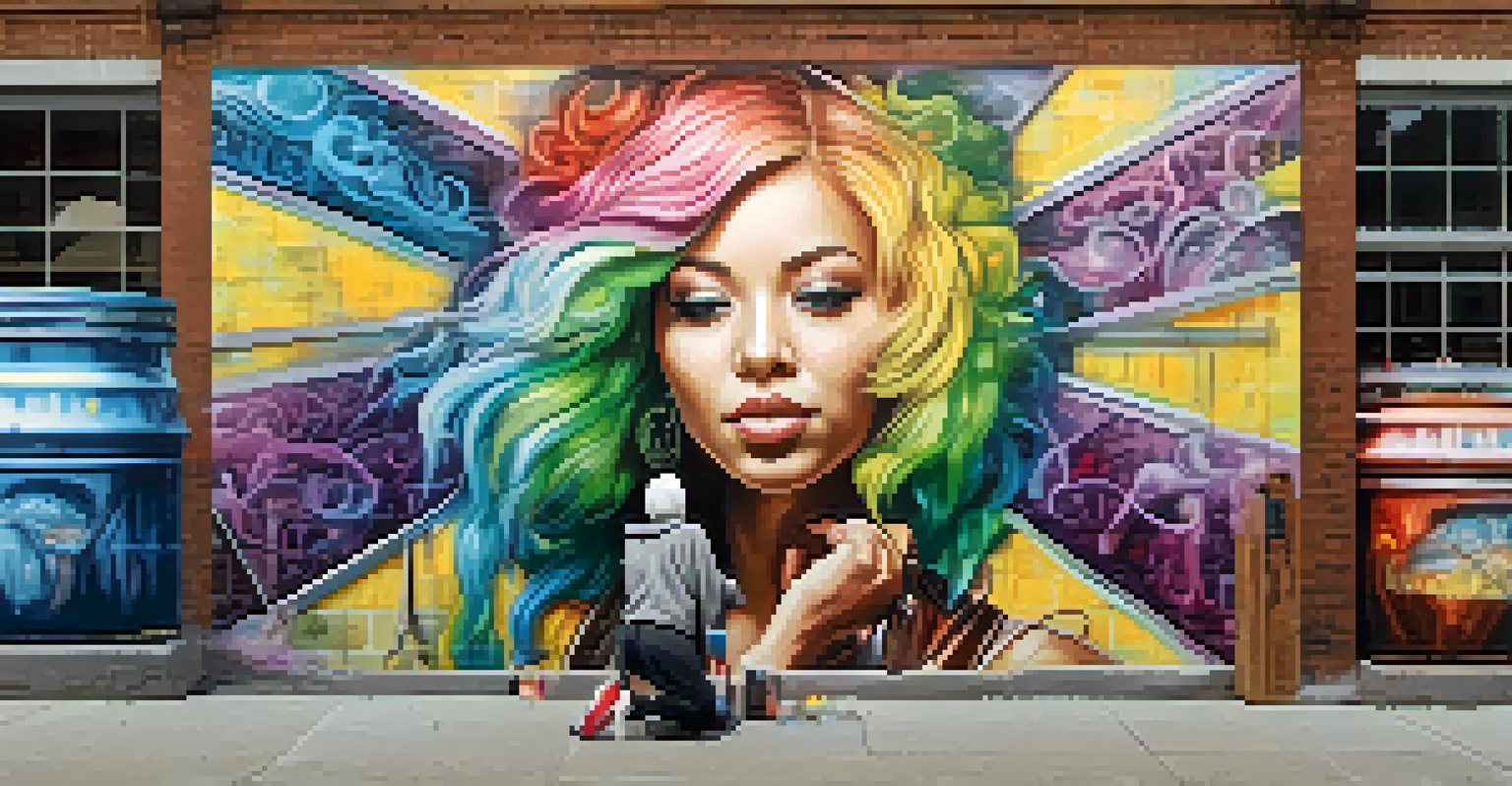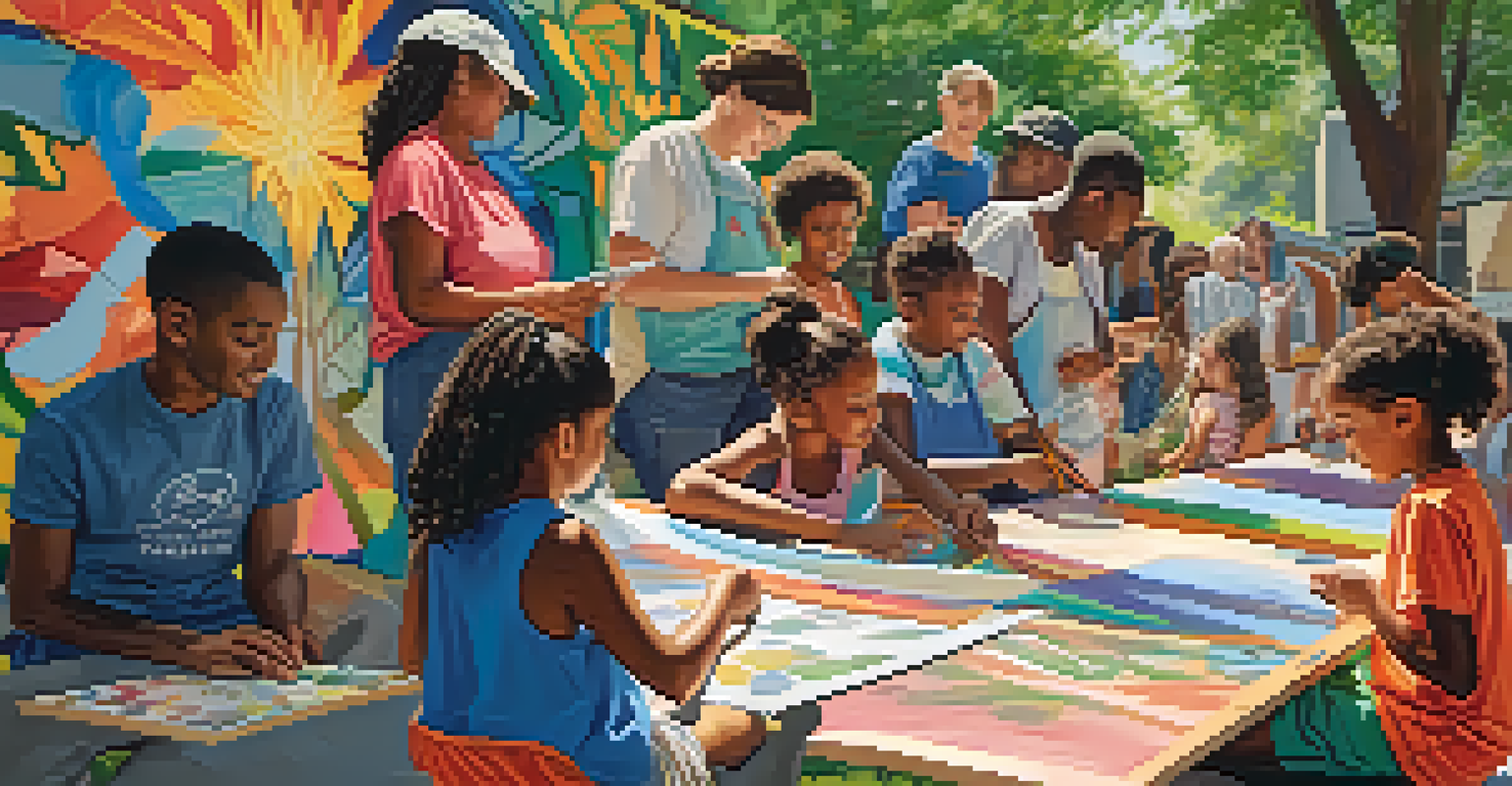Street Art: A Voice for Community Identity and Expression

What is Street Art and Why Does it Matter?
Street art is more than just graffiti; it's a powerful form of expression that can communicate community stories and identities. Often found in public spaces, it transforms ordinary walls into canvases that reflect local culture, struggles, and triumphs. This art form allows artists to share their perspectives and emotions in a way that resonates with the community, making it a vital part of urban life.
Art is not a mirror to reflect the world, but a hammer with which to shape it.
Unlike traditional art, which may be confined to galleries, street art invites everyone to participate in the conversation. It breaks down barriers, encouraging dialogue among diverse audiences. By engaging with their environment, artists challenge societal norms and provoke thought, fostering a sense of belonging and pride within the community.
Additionally, street art often addresses social issues, shining a light on topics like inequality, identity, and environmental concerns. This unique ability to spark conversations makes street art a crucial element in advocating for change and amplifying the voices of those who may feel unheard.
Street Art as a Reflection of Community Identity
One of the most compelling aspects of street art is its capacity to reflect the identity of a community. Artists draw inspiration from their surroundings, incorporating local history, culture, and symbols into their work. This connection creates a sense of familiarity and pride among residents, as they see their stories and experiences depicted on their streets.

For example, in neighborhoods with rich cultural heritages, murals may celebrate historical figures or significant events that shaped the area. These artworks serve as visual reminders of a community's roots, fostering a collective memory that unites residents. As people engage with these pieces, they develop a deeper appreciation for their environment and the narratives that define it.
Street Art as Community Expression
Street art serves as a powerful medium for artists to convey local stories and identities, fostering a sense of belonging within communities.
Moreover, street art can evolve over time, reflecting changes within the community. As new residents move in or social dynamics shift, artists may adapt their work to address emerging themes or concerns, ensuring that the art remains relevant and representative of current identities.
The Role of Street Art in Social Movements
Street art has played a crucial role in various social movements, serving as a medium for protest and activism. Artists often use their work to comment on social injustices, acting as visual advocates for change. This form of expression resonates deeply with community members who may share similar struggles, creating a powerful sense of solidarity.
The role of the artist is to make the revolution irresistible.
For instance, during movements like Black Lives Matter, street artists have created poignant murals that honor victims of police violence and highlight the ongoing fight for racial equality. These artworks not only raise awareness but also inspire action, encouraging community members to engage in activism and support one another.
Furthermore, the visibility of street art makes it an effective tool for reaching a wider audience. By placing important messages in public spaces, artists can challenge passersby to rethink their perspectives and inspire dialogue about pressing issues that affect their communities.
The Impact of Street Art on Urban Spaces
Street art significantly impacts urban environments, transforming dull and neglected areas into vibrant cultural hubs. A well-placed mural can breathe new life into a forgotten wall, attracting visitors and sparking interest in the surrounding area. This revitalization can lead to increased foot traffic, benefiting local businesses and fostering a sense of community pride.
Moreover, cities that embrace street art often become known for their creative landscapes, drawing tourists eager to explore these outdoor galleries. This influx of visitors can stimulate economic growth while simultaneously enriching the local culture. As a result, many municipalities are beginning to recognize the value of supporting street artists and incorporating their work into urban planning.
Impact on Urban Environments
Street art revitalizes neglected urban spaces, attracting visitors and enhancing local culture while supporting economic growth.
In the long run, the presence of street art can contribute to a city's identity, making it unique and memorable. As communities invest in their artistic expressions, they cultivate a sense of ownership over their spaces, encouraging residents to take pride in their neighborhoods.
Challenges Faced by Street Artists
Despite its significance, street art often faces numerous challenges, primarily legal and societal hurdles. Many artists operate in a gray area, as their work is frequently deemed vandalism, leading to potential fines or arrests. This precarious position can deter talented individuals from sharing their art, limiting the diversity of voices within the street art scene.
Additionally, public perception of street art can vary widely. While some view it as a legitimate form of artistic expression, others dismiss it as mere graffiti. This dichotomy can create tension between artists, community members, and local authorities, complicating efforts to promote street art as a valuable cultural asset.
To address these challenges, many cities are beginning to implement policies that support street artists, providing designated spaces for them to create legally. By fostering an environment where street art is celebrated rather than punished, communities can encourage artistic expression and embrace the vibrant narratives that emerge from it.
Collaborative Street Art Projects
Collaborative street art projects have emerged as a powerful way to strengthen community ties and foster creativity. These initiatives often involve local artists, residents, and organizations coming together to create large-scale murals or installations that reflect shared values and experiences. By working collaboratively, participants can forge connections and build a sense of belonging.
For example, community mural projects may involve workshops where residents contribute their ideas and designs, making the artwork a true representation of the neighborhood. This inclusive approach empowers individuals to take ownership of their environment, ensuring that the final product resonates with the community's identity.
Challenges for Street Artists
Despite its significance, street artists often face legal and societal hurdles that can limit their ability to express diverse voices.
Furthermore, these collaborative efforts can serve as valuable opportunities for education and skill-building. Participants can learn about artistic techniques, teamwork, and the importance of public art, fostering a new generation of artists and advocates for their community.
The Future of Street Art and Community Engagement
As urban landscapes continue to evolve, the future of street art appears bright, particularly in its role in community engagement. With the rise of social media, artists can share their work with a global audience while simultaneously connecting with local residents. This newfound visibility can lead to increased support and collaboration, amplifying the impact of street art within communities.
Moreover, as more cities recognize the value of public art, we can expect to see a growing number of initiatives aimed at supporting street artists. These may include funding opportunities, public art festivals, and partnerships with local organizations, all of which can help create an environment that nurtures creativity and fosters community pride.

Ultimately, the future of street art lies in its ability to adapt and respond to the needs of the community. By listening to the voices of residents and embracing diverse perspectives, street art can continue to serve as a powerful catalyst for connection, identity, and positive change.